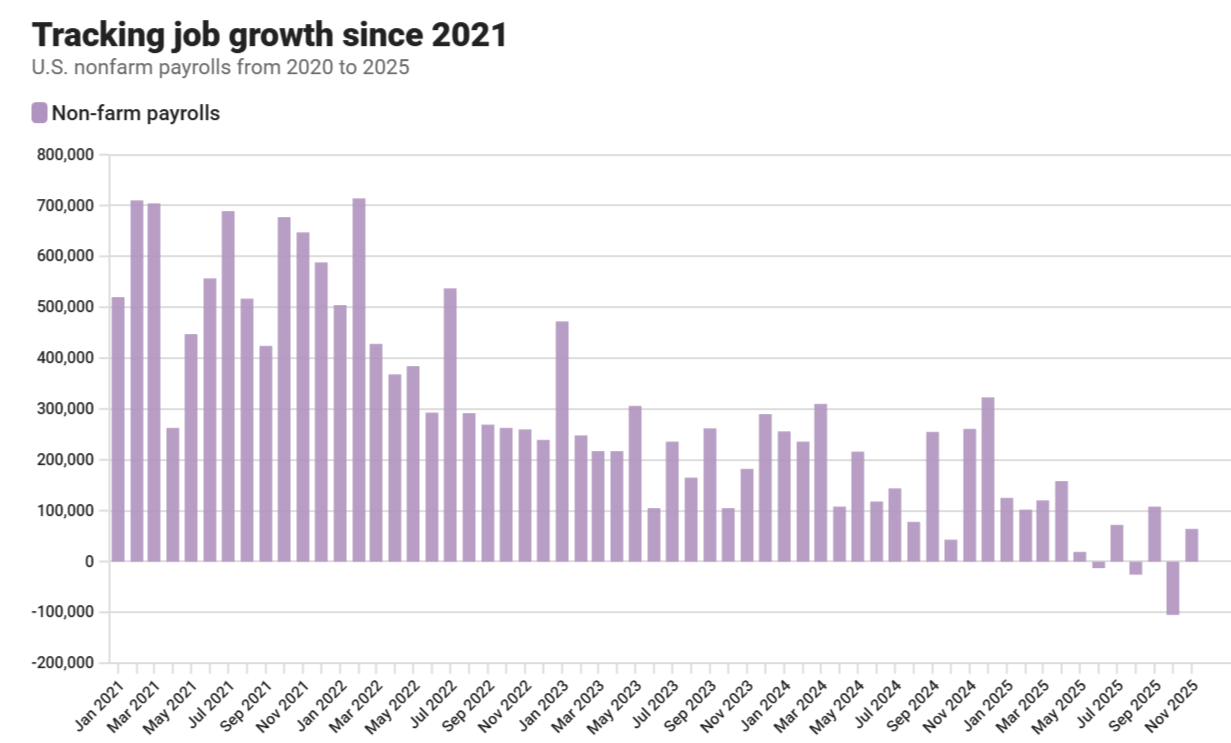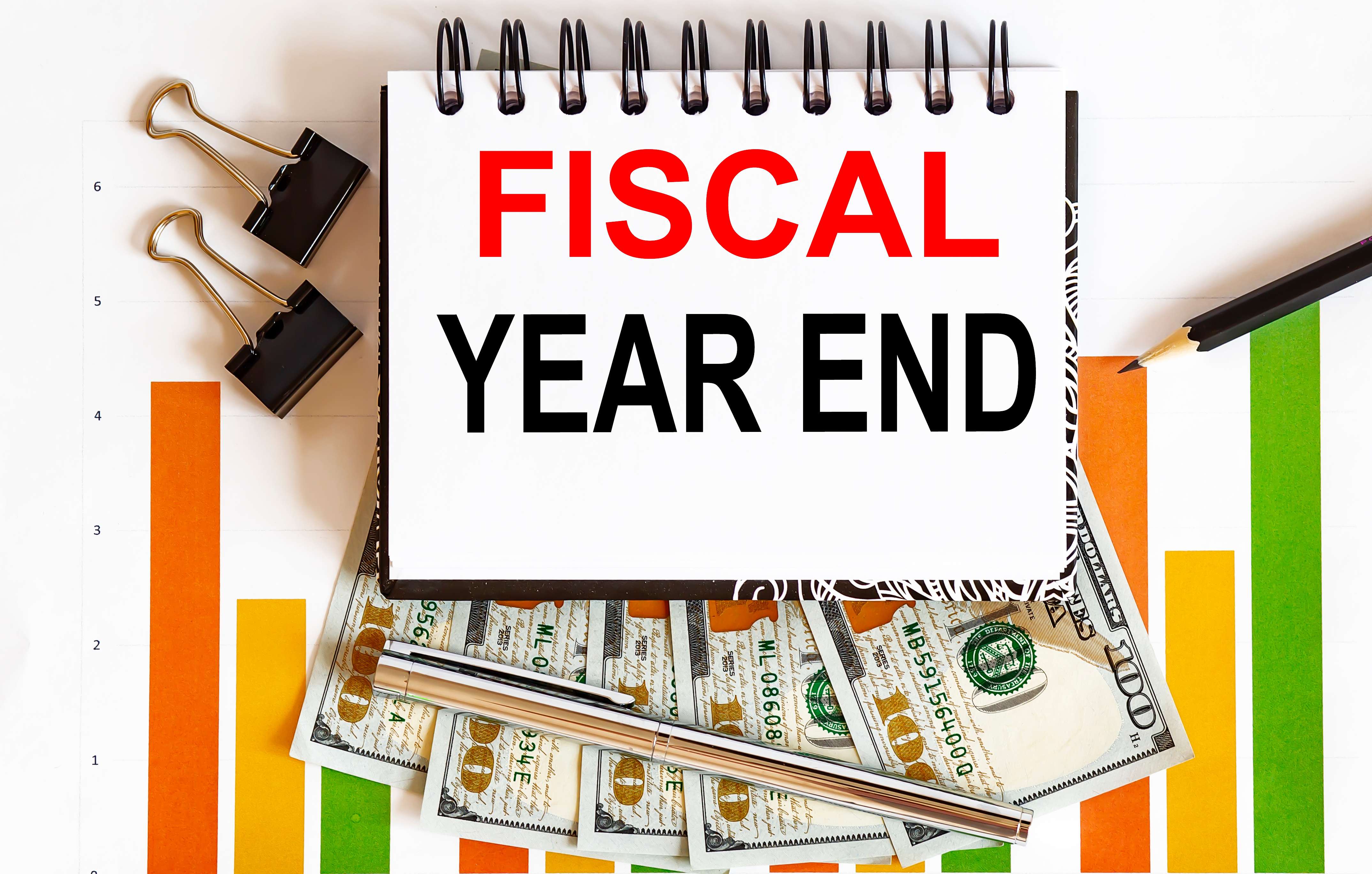 Burn rate is the rate at which a startup business is spending (gross) or losing (net) its cash supply over time. It is normally analyzed on a monthly basis. You can think of it as the rate of negative cash flow. Now an Investopedia article points out that “in some crisis situations, the burn rate might be measured in weeks or even days,’ it also states that an “analysis of cash consumption tells investors whether a company is self-sustaining, and signals the need for future financing.”
Burn rate is the rate at which a startup business is spending (gross) or losing (net) its cash supply over time. It is normally analyzed on a monthly basis. You can think of it as the rate of negative cash flow. Now an Investopedia article points out that “in some crisis situations, the burn rate might be measured in weeks or even days,’ it also states that an “analysis of cash consumption tells investors whether a company is self-sustaining, and signals the need for future financing.”
Successful startups invest heavily in growth. They have to hire the right people, buy equipment or software, and maybe even pay for excess server capacity to keep a product or service from crashing. Growth isn’t cheap—and that spending fuels the investor venture capital and startup industry. A burn rate is a financial analysis metric that is mainly used for investor funded startup companies that are quite often unprofitable in their early years and are usually in disruptive or promising high growth industries. Most startups take several years to become profitable from its sales or revenue and as a result, they require adequate supply of cash on hand to meet their monthly expenses. Many technology and biotech startups face years of living on their investor bank balances. Let’s take the example of Uber, which is an 11 year old previous Unicorn startup, that IPO-ed in 2019 and still has yet to turn a profit.
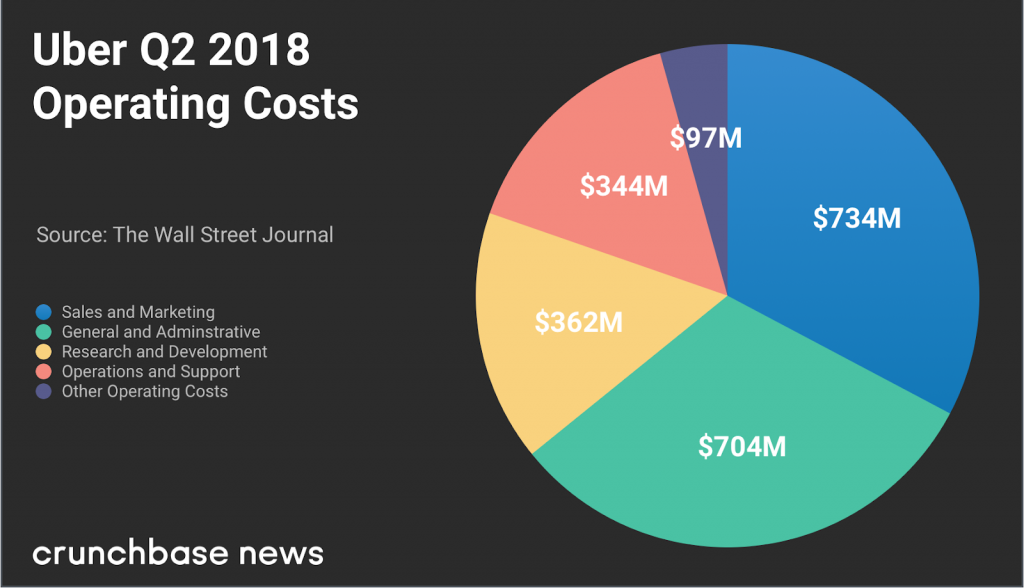 (image credit: Crunchbase)
(image credit: Crunchbase)
Some Burn Rate takeaways from Investopedia to consider:
- VC Investors often conduct due diligence into a startup’s available cash, its capital expenditures, and its burn rate before making an investment decision
- A startups burn rate is a measure related to how fast a company spends its available supply of cash
- If a startup burns it’s cash too fast, they run the risk of running out of money and closing its doors permanently
- If a startup doesn’t spend or burn enough cash, it might not be investing in its future and may get surpassed by its competitors
- The cash flow statement includes information related to a company’s burn rate
Types of Burn Rates
An article by Zeni.ai points out that the three most common types of startup burn rate calculations are cash burn, gross burn, and net burn.
- Gross burn rate is the total amount of cash you’re spending per month.
- Net burn rate is the total amount of cash you’re losing per month.
- Cash burn rate is the change in cash balance month over month.
For the owner or founders of a startup, figuring out burn rate is critical to building and growing a sustainable business; it’s the foundation for understanding startup runway ( I will explain this concept later) and helps to figure out the amount of money in VC funding you will require to get to the next stage of the companies cycle.
Gross Burn Rate
Gross burn rate is the total amount of cash you’re spending per month. Its calculated by:
Total Monthly Operating Expenses = Gross Burn Rate
Gross burn is a more literal calculation of outgoing cash, combining all of your monthly expenses as found on your income statement (P&L) to determine your burn rate. To find your average gross burn rate, add up the results of your monthly calculations, and divide by the number of months included. The Zeni.AI article also points to a quote from a well known Venture capitalist named Fred Wilson on burn rates “You look at your monthly expenses on your income statement. Add all of them up. And then look at any outlays of cash for capital expenditures or other regular uses of cash on the balance sheet and cash flow statement. Add all of these monthly cash outlays together. This is ‘gross burn rate’.”
So a pretty well known VC named Mark Suster wrote an insightful post back in 2014 called What is right burn rate for a startup company? And he describes “Gross burn as the total amount of money you are spending per month,” and that “Net burn is the amount of money you are losing per month.” He also explains that most investors will look more closely at the net burn numbers. He gives a hypothetical example.
“So if your costs are $500,000 per month and you have $350,000 per month in revenue then your net burn (500–350) is equal to $150,000. The reason that most investors quickly zero in on net burn is that if you have $3 million in your bank account and have a net burn of $150,000 per month you have more than 18 months of cash left provided your net burn stays constant. Conversely if you’re burning $600,000 per month (yes, some companies do) then you only have 5 months of cash left.”
Gross burn rate can give founders a clear picture of how much cash is being spent each month. It’s also a financial metric all venture capitalists, investors and board members will want to know at a high-level, review at a more detailed level and keep tabs on over time. Even Mr Suster states that “Gross burn is not irrelevant.” Especially when the market overall turns south, the revenue line drops. He mentions that startups are particularly vulnerable if:
- You have revenue concentration (few customers each providing a large total of percentage of your revenue)
- You have a large number of startup customers (because when markets crash they have a funny way of going bankrupt quickly or cutting burn precipitously)
- You are reliant upon ad revenue (this is a variable spend which corrects quickly during a market correction)
- You are discretionary spend (aspirin) versus necessary spend (prescription medicine)
Net Burn Rate
Net burn rate is the total amount of cash you’re losing per month. You calculate by taking;
Total Monthly Revenues – Total Monthly COGS – Total Monthly Operational Expenses = Net Burn Rate
The net burn rate calculation looks at your startup company’s total expenses and total income in a given month, including proceeds from revenue and cost of sales, to determine burn rate. This is the same figure as Net Income on your monthly P&L statement.
To find your average net burn rate, add up the results of your monthly calculations, or monthly Net Income figures from your P&Ls, and divide by the number of months included. Obtained your P&L statement (Net Income) which includes COGS, net burn provides the most comprehensive view of burn by weighing revenue and income against expenses. The net burn rate also uses accrual accounting which makes for a more consistent calculation and contextual alignment with the rest of your financial records which use accrual accounting method. As mentioned earlier, many investors and board members like using the net burn rate. One thing to mention if there is a downside to using this method, you really need to have well organized bookkeeping structures in place that are accurately tracking COGS, operating expenses and revenue to find the true net burn rate.
 Cash Burn Rate
Cash Burn Rate
Cash burn rate is the change in cash balance month over month.You can calculate by taking your:
Cash balance from prior month – Cash balance in current month = Cash burn rate
Cash burn rate takes total cash balance from the prior month minus the cash balance in the current month to determine your current cash burn rate. Beware that including VC-funding in your cash burn rate calculation does not always give you a realistic view of how much money is being spent/lost, and may lead to cash burn issues down the line.
For this reason, venture capital-backed startups may wish to exclude recent VC funding from this calculation. To do so, the calculation would be:
To find your average cash burn rate, add up the results of your monthly calculations, and divide by the number of months included. For example:
Jan Cash Burn: $124,000+
Feb Cash Burn: $126,000+
Mar Cash Burn: $127,000 = Sum of Three Months: $377,000
/ Number of Months: 3 = Average Monthly Cash Burn Rate: $125,667
This calculation can be used to determine your average burn rate across cash burn, gross burn or net burn; just swap out the figures accordingly. The cash burn rate calculation is very straight-forward can be done using your company’s bank account statements vs monthly financial statements (income or profit & loss statement (P&L), balance sheet, and cash flow statement). This makes it easy for business leaders to calculate it themselves. But as the Zeni.AI article points out that one of downsides to using the cash burn rate, is that it is calculated using the cash basis accounting method, when most startups use accrual basis accounting method. Accrual accounting recognizes revenue as it is earned, rather than when it is paid to the company. When the rest of your finances are managed and reported using accrual accounting, having one report using cash basis leads to misunderstandings for why things ‘don’t add up’. Because you are using cash basis to determine cash burn rate, your burn rate is more likely to experience notable fluctuations from one month to the next. Say for example, that your company made a credit card payment in February for expenses generated in January, your cash burn for January will be significantly lower and cash burn for February significantly higher.
MatterMark Data Company Burn Rate Analysis Example
In 2015, Danielle Morrill, a co-founder of Mattermark, a business intel software company, documented and wrote a blog post titled “How we spend money at Mattermark: What goes Into our Burn Rate?” where dives into their company’s monthly cash burn spending. Mrs Morrill states
“each month, we look at the change to our bank balance and ask, “was it greater or less than $400K? And if it was greater, why?” We dive into more of how we think about burn in Important Financial Indicators for Startups at Every Stage of Growth. In the graph below, you can see that our monthly burn rate was around $420K.”
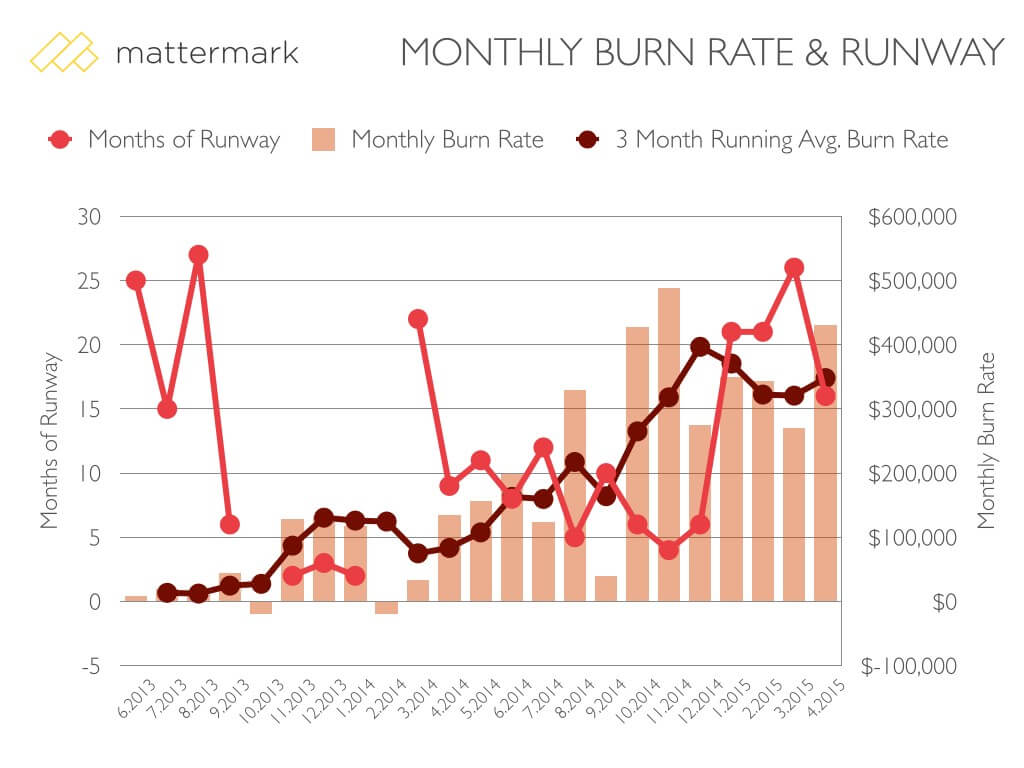 In June, our burn rate was $420K.
In June, our burn rate was $420K.
In June we collected $293K of bookings revenue and spent $713K.
Another way to express this is to say we covered 41% of our June expenses with cash collected, and money raised from investors covered the other 59%.
Let’s make it more real. Where does the money go each month?
-
- $525K for 43 headcount. This includes salaries, payroll tax, full coverage of medical/dental premiums, bonuses, commissions, PTO, and severance expenses.
- $45K for 11,000 SQFT of office space in San Francisco
- $30K for COGS (servers, data licensing, payment processing etc.)
- $25K in marketing expenses (marketing experiments)
- $25K for stuff to “get work done” like office supplies & SaaS software tools (laptops, CRM software, marketing automation software, telecom, food/drinks)
- $25K for outside services (recruiter fees, HR training, payroll, and accounting)
- $14K for travel (sales calls, board meetings, our Seattle office)
-
- $14K for legal (we pay this once a year, but accrue monies for the annual bill)
- $10K for facilities (garbage, water, electricity, janitorial, etc.)
Why is this important? – just 2 years later, without being able to win enough market share away from established capital market data software players CB Insights, Crunchbase, Pitchfork to convince enterprise customers to pay for business intel they ended having to sell in a firesale. A Denver based firm, FullContact paid less than $1M for Mattermark, which had raised over $17M in funding from such investors as Andreessen Horowitz, NEA, 500 Startups, Foundry Group and Sherpa Capital.
Because of the very low sale price, employees of Mattermark where not set to receive any proceeds, and the company’s venture backers are not likely to see a return, either. Running a startup is hard and if you don’t figure out your product market fit and customer adoption, then you may end not making it.
Relationship Between Burn Rate and Startup Runway
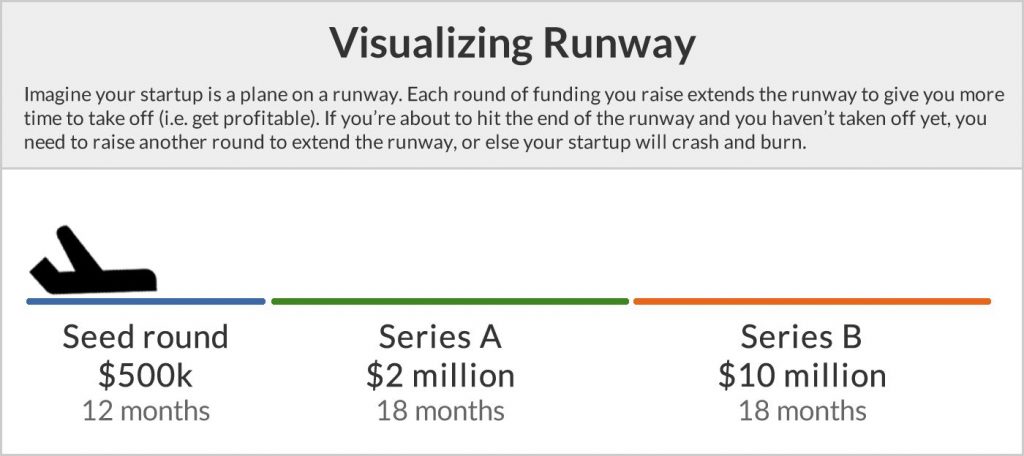
(image credit: lessannoyingcrm.com)
The whole point of knowing what your burn rate is to calculate or estimate when you will run out of money or how many months of runway you have left. As Fred Wilson points out “If you had unlimited funds, burn rate would be an irrelevant number. But I’ve never seen a company with unlimited cash. So entrepreneurs, CEOs, and certainly CFOs should always know how much cash they have and if they are burning cash, they should know the rate at which their cash balance is going down. And of course, they should know the date on which they will have no cash left.”
Use your average net burn rate and current cash balance to determine how many months your company can continue operating before it tunes out of cash.
Cash balance in current month / Average Net Burn Rate = Startup Runway, or Number of Months Until You Are Out of Cash
Another thing that Mr Wilson mentions that investors will examine more closely is any accounting “irregularities”, such a say a CFO reports to the board that the Company has a net burn rate of $100,000/month, but the cash balance has gone down by $1mm in the past five months, it’s a signal that something’s not right. And then you have to dig deeper.
He mentions that when you do these “deeper dives” you often run into “one time expenses”. “Well, we had to lay out a huge security deposit in February that was a big hit to cash” or “our legal fees on the big contract with IBM were a big hit to cash in June”. But my view is if a company has big “one time expenses” every month or two, they really aren’t one time expenses. The burn rate calculation needs an accrual for these sorts of things in it.
Bottomline – one of the main responsibilities of the management team and the board is cash management and financial planning. Understanding the impact of the business’s burn rate in conjunction with milestone planning for fundraising is an essential component of this responsibility.
Burn rates can change pretty quickly up or down
If revenues are ramping faster than expenses consistently month after month, the burn rate will go down. And for good reason – the company is getting closer to making money, which is what all this stuff is about at the end of the day. Burn rate can also move the other way where expenses are increasing faster than revenues or if there are no revenues. This will mean you will run out of cash faster. As Mr Wilson says “If your burn rate is going up, from $83,333 per month to $100,000 per month, then the $250,000 you have left will not last three more months. It might only last 2 1/2 months.”
Knowing the burn rate is what signals to existing investors how quickly startup’s team needs to be fundraising and the level of risk the company is facing and also it signals to potentially new investors both how quickly you need to raise (ie you have less leverage if you’re in a rush) as well as how much cash you’ll need if they fund you.
Deploying the VC investor capital strategically to fuel growth

In Mark Suster’s article he talks about startup companies that are scaling quickly in revenue and with a high gross margin often should invest as much capital in growth as they can manage responsibly because when you find a product / market fit and your company is growing at a very fast scale you want to capture market share before competition sets in. He says think Zoom, DropBox, Airbnb, and Uber (I know but granted this was written back in 2014). If you have a software product, then you should be investing in
- engineering (to maintain your product lead)
- new offices / locations (to capture markets before others),
- marketing (to capture consumer attention before others do)
The unit economics of the business matter a great deal. If the unit economics of a startup are strong, that’s a great leading indicator to finance growth and increase burn.
All of these activities consume cash often in advance of the revenue they generate. But you must also think about what is the availability of capital?
Availability of Capital
There really is no simple or one answer to the question “how much should a startup burn?” Mr Suster’s perspective is that your startup should stay lean as long as possible and “only raise a big round if you DO find product / market fit and which point you want to loosen the belt quickly and raise the capital to do so.”
He also states that if you are a well funded and promising startup that has strong support of VC firms then you might be more comfortable with accepting a higher burn rate (say $300k or $400k per month) than a company with angel money and less cash in the bank. And if you are reaching hyper growth and raised $40 million “it is not crazy to think you might burn net $1 million / month (> 3 years of cash remaining) providing you are growing fast enough to justify burning $12 million / year.” From an investors perspective Mr Suster states “your value creation must be at least 3x the amount of cash you’re burning or you are wasting investor value.” If you raise $10 million at a $40 million valuation that investor needs you to exist for at least $120 million (3x) to hit their MINIMUM return target their investor’s are expecting. So he is saying that any of the money you take from investors should add equity value or create Intellectual Property (IP) that eventually will. Startup founders must take advantage of favorable financing periods and attractive interest rates to improve the company’s cash position and access to working capital.
The final piece to think about on how cautious you should be with your monthly burn rate, it can come down to if or when you need to raise venture capital financing again will you be able to raise at a higher valuation or price? As Tomaz Tunguz, a VC at redpoint mentions “part of this ability lies within the team, and the team’s ability to position and sell the story of the business.” He goes to further state that, “another component is the market’s receptivity to the story given the financial conditions of the market, which is harder to gauge and difficult to predict.”
If the market turns, excitement wanes and your valuation is completely out of whack with your underlying performance then your company could be faced with having to accept unfavorable financing terms, such as taking a down round funding.
Conclusion
You should pay attention to your runway. Should you be cutting back on expenses to lengthen your cash runway? Mr Suster suggests that you should “be careful about ever dipping below 6 months of cash in the bank. Take cash balance plus the net of your receivables & payables to get “net cash.” Divide net cash by your monthly net burn rate as an approximation of how many months of cash you have. You really need to subtract the final month.” The VC Fred Wilson states that during that period of cash consumption, it is critical to keep a close eye on cash balance and burn rate and cash out date. It will tell you when you need to raise money again (at least six months before you run out of cash please!). And it will tell you how much you are investing on a monthly basis in your company. These are important numbers to know, to internalize, and to operate with. Solid bookkeeping and accounting systems is the backbone and since nobody wants to accidentally run out of money… or fail to raise a Series A round due to messy books! Know where you are spending your money so you can manage costs, control your burn and look good to investors. Solid recordkeeping means you can cut your burn by capturing an R&D tax credit – this could save your startup up to $250,000 a year. If you have any questions feel free to contact Huckabee CPA for a free consultation.



